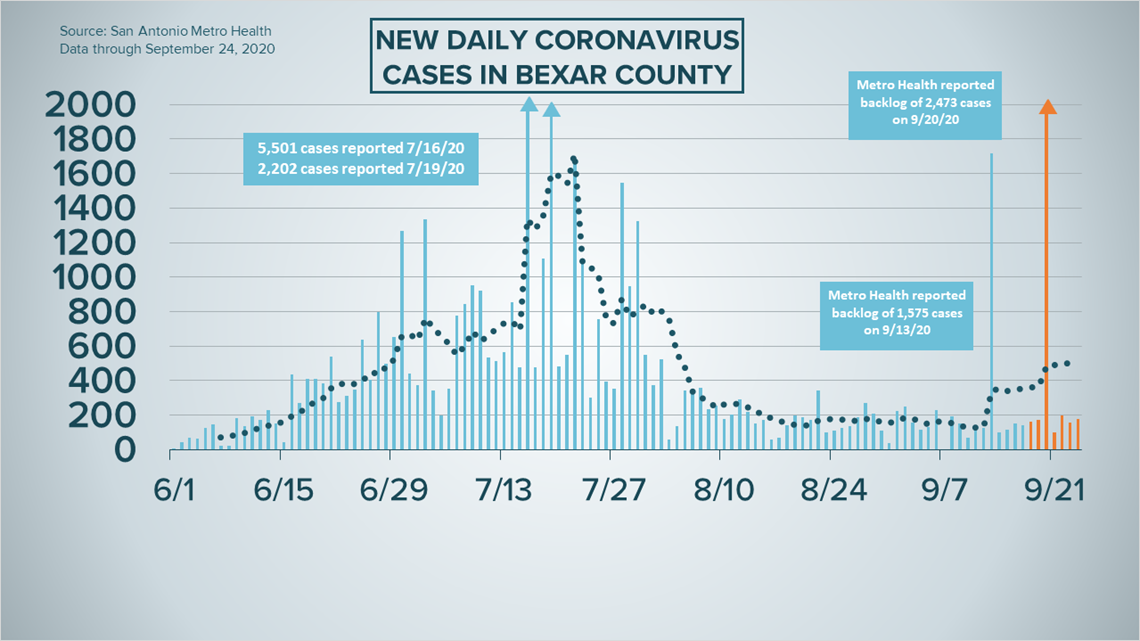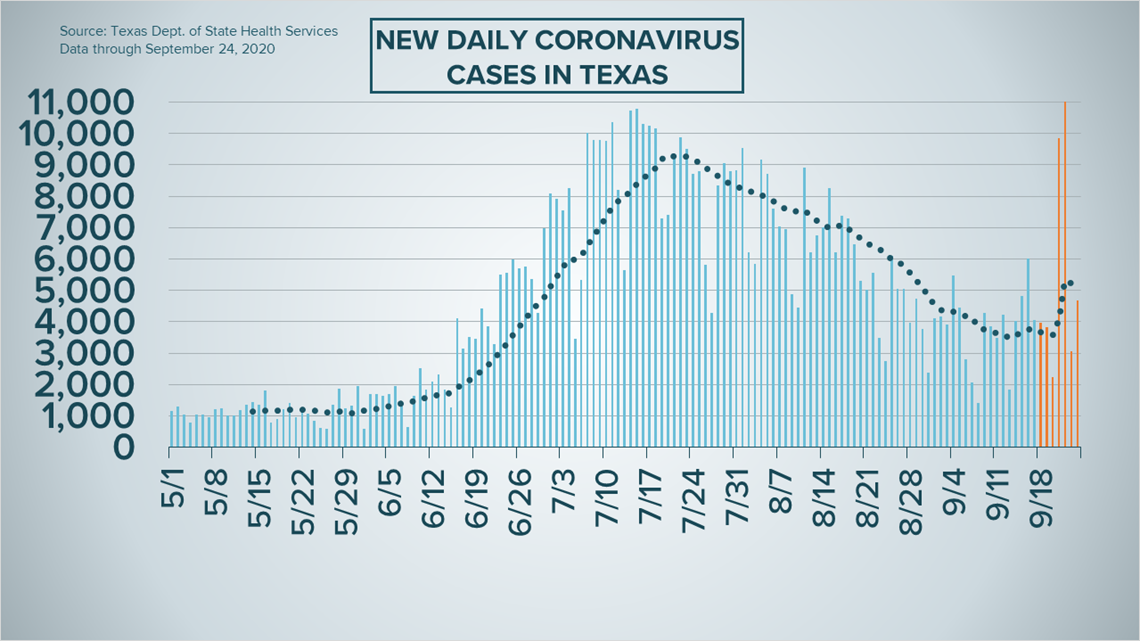SAN ANTONIO — We're tracking the latest numbers from the coronavirus pandemic in San Antonio and across Texas. Here are the latest numbers reported by Bexar and surrounding counties:
- Bexar County: 177 new cases were reported Thursday, bringing the total number for the county to 53,971. The county death toll rose to 1,073 as five additional fatalities from over the past two weeks were reported.
- Comal County: The county reported 49 additional cases on Thursday. No additional deaths were reported. There have been a total of 3,410 cases of COVID-19 in the county – including 2,694 confirmed cases – while 116 county residents have died. County officials say there are 235 active coronavirus cases, and 3,059 residents are considered recovered.
- Hays County: Officials in Hays County on Thursday reported 14 new cases in the county and no additional virus-related deaths. As of Thursday, there are a total of 5,832 lab-confirmed cases in the county (1,577 of which are active) while the death toll remains at 54. 4,201 residents have recovered from the virus.
How Bexar County is trending
We've tracked how many coronavirus cases have been confirmed in Bexar County from the time officials began reporting cases in March 2020. The graphic below shows the number of cases since June and charts those daily case numbers along a 7-day moving average to provide a more accurate picture of the overall coronavirus case curve in our area and the direction we're trending amid the pandemic.
On Thursday, San Antonio Mayor Ron Nirenberg reported 177 new coronavirus cases for the area. That's 22 more than Wednesday's daily total, and brings the total to 53,971 diagnoses in the ongoing pandemic.
Nirenberg also reported five additional coronavirus-related deaths from over the past two weeks, including a female resident under the age of 19. In all, 1,073 Bexar County residents have died from coronavirus complications.


Meanwhile, the total number of county residents receiving treatment for COVID-19 symptoms rose by three on Thursday, to 231. Of those, 36 are using ventilators and 87 are in intensive care at local hospitals.


Coronavirus in Texas
The number of Texans who have tested positive for the coronavirus since the pandemic began grew by 4,320 on Thursday, according to the Texas Department of State Health Services. Of that increase, 3,840 are attributed to newly-reported coronavirus cases. Another 480 cases in the total stem from a number of backlogs throughout several counties:
- 17 cases recently reported by labs in Collin County.
- 20 cases recently reported by labs in Dallas County.
- 438 cases recently reported by labs in Harris County.
- 2 cases recently reported by labs in Franklin County.
- 2 cases recently reported by labs in Titus County.
- 1 case recently reported by labs in Hopkins County.
In total, 723,919 Texans have tested positive for COVID-19. An estimated 642,000+ have recovered.


The number of hospitalizations on Thursday rose slightly to 3,204, which amounts to nine more Texans receiving treatment for COVID-19 symptoms in the last 24 hours.
The state's public school COVID-19 data dashboard had reported 1,212 new student cases for the week, bringing the total to 3,445 positive cases out of an estimated 1.1 million students learning in-person. The total count of on-campus staff cases rose to 2,850 after 660 new cases were reported. The data on the DSHS' website will be updated weekly on Wednesdays.
Meanwhile, the state on Thursday reported that, as of this week, there have been 86 cumulative COVID-19 cases between on-campus staff and students between San Antonio's three biggest districts. More on that can be found here.
The number does vary from figures reported by Nirenberg at Thursday evening's COVID-19 presser, where he said that a total of just 52 students and staff "across our area" have tested positive. It's unclear what accounts for the discrepancy.


Latest Coronavirus Headlines
- Mark Cuban says every U.S. household should receive $1,000 stimulus check every 2 weeks for next 2 months
- Doctors begging companies to include pregnant women in coronavirus vaccine trials
- New state report shows 86 COVID-19 cases overall at SA's top 3 districts
- Democrats drafting new coronavirus relief bill with more direct payments to Americans
- United to start offering rapid COVID-19 tests for some passengers
- Uber bans 1,250 riders for not wearing masks as new rules roll out
- How can I tell the difference between the flu and COVID-19?
- US experts vow ‘no cutting corners’ as COVID-19 vaccine tests expand
Coronavirus symptoms
The symptoms of coronavirus can be similar to the flu or a bad cold. Symptoms include fever or chills, cough, shortness of breath or difficulty breathing, fatigue, muscle or body aches, headache, new loss of taste or smell sore throat, congestion or runny nose, nausea or vomiting and diarrhea, according to the Centers for Disease Control.
Most healthy people will have mild symptoms. A study of more than 72,000 patients by the Centers for Disease Control in China showed 80 percent of the cases there were mild.
But infections can cause pneumonia, severe acute respiratory syndrome, kidney failure, and even death, according to the World Health Organization. Older people with underlying health conditions are most at risk.
But infections can cause pneumonia, severe acute respiratory syndrome, kidney failure, and even death, according to the World Health Organization. Older people with underlying health conditions are most at risk.
Experts determined there was consistent evidence these conditions increase a person's risk, regardless of age:
- Chronic kidney disease
- COPD (chronic obstructive pulmonary disease)
- Obesity (BMI of 30 or higher)
- Immunocompromised state (weakened immune system) from solid organ transplant
- Serious heart conditions, such as heart failure, coronary artery disease, or cardiomyopathies
- Sickle cell disease
- Type 2 diabetes
The CDC believes symptoms may appear anywhere from two to 14 days after being exposed.
Human coronaviruses are usually spread...
- Between people who are in close contact with one another (within about 6 feet).
- Through respiratory droplets produced when an infected person coughs, sneezes or talks. These droplets can land in the mouths or noses of people who are nearby or possibly be inhaled into the lungs.
- Some recent studies have suggested that COVID-19 may be spread by people who are not showing symptoms.
Help stop the spread of coronavirus
- Stay home when you are sick.
- Eat and sleep separately from your family members
- Use different utensils and dishes
- Cover your cough or sneeze with your arm, not your hand.
- If you use a tissue, throw it in the trash.

